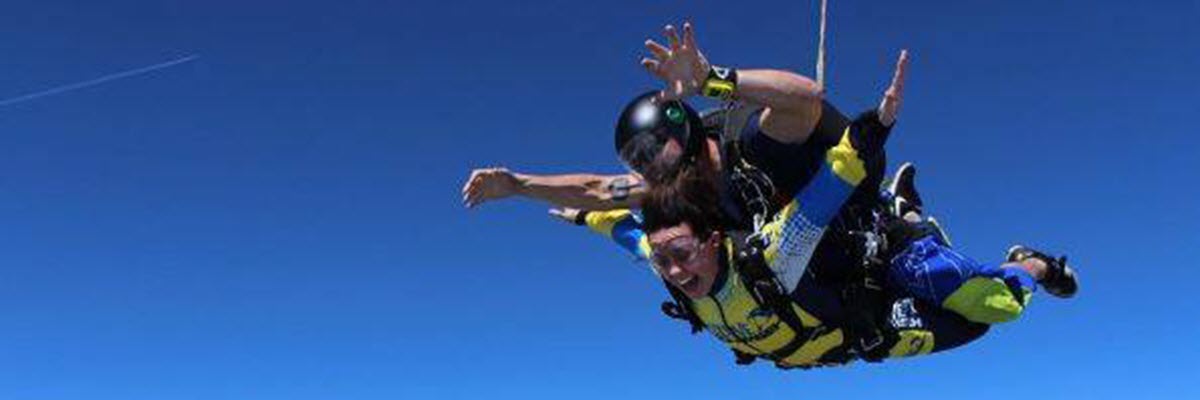- Michigan's Premier Skydiving Center
- Call Now: (517) 423-7720

Does Skydiving Hurt Your Ears? 3 Things to Know
Tuesday, November 14, 2017
- Skydive Tecumseh
- 11/14/17
- 0
- General
What if I told you that one of the most common skydiving injuries is totally invisible?
Popular misconception imagines that a skydiving injury always ends up with a jumper on crutches–or at least with a cast–but that myth ain’t true at all. In fact, one of the most common skydiving injuries is as invisible to the naked eye as it is totally preventable: Ear damage. Tandem skydivers are as susceptible to this one as the zoomiest solo skydiver in the wide blue yonder, but don’t worry: Protecting your ears from an injury on a tandem skydive is simple. All that’s necessary is that you know what to expect and arrive prepared to mitigate your risk. Here’s what you need to do:
1. Arrive Prepared for the After Effects of Skydiving
Skydiving is noisier than you might imagine. Your ears will be packed full of decibels, from the roar of the plane’s engine to the waterfall thunder of the wind in freefall. In the same way that you protect your ears when you’re heading out to hang out by the speakers in the front row of a concert, you’d be best advised to protect your ears when you head out to the dropzone for a skydive. Tandem skydiving students often find it helpful to bring a pair of trusty earplugs along with them to the dropzone.
If you’re worried that wearing earplugs will dull the experience, don’t. Wearing earplugs on a tandem skydive will only make the experience more pleasant and enjoyable, not less.
2. How to Equalize Your Ears After Skydiving
Another way you can take charge of the whole “ear situation” is by regulating your ear pressure on the way to altitude (and under canopy on the way back down again. When you’re in a skydiving airplane that’s cranking up to exit altitude, you’ll be moving from the thicker air molecules at ground level to the thin air molecules of the upper atmosphere. The air pressure against your eardrums steadily decreases while the pressure in the inner ear remains constant. The eardrum bulges outward in response, reducing the clarity of your hearing and causing discomfort. Predictably, the opposite dynamic kicks in as you descend. Under most conditions, this won’t harm you–but, under some conditions, it might. More on that later.
If you’ve ever been scuba diving, you’ll understand this immediately: That clearing your ears is an important ritual when you’re facing changing environmental pressurization. This is easy to forget, especially if you’re nervous–and not a whole lot of people know about it, even expert skydivers, so you might even start a healthy trend at the dropzone you visit!
3. Know When Not to Jump
Take ownership of your auditory health. Are your sinuses congested? Suffering from a head cold? Treating an ear infection? We highly suggest that you reschedule your jump. That shortlist of illnesses all have the potential to block up your eustachian tubes, which connect the middle of each ear to your throat and nose. A blocked eustachian tube can’t do its job–regulating pressure–properly, which could lead to a… (eep!) burst eardrum. If you decide to make a skydive when you’re congested and your eustachian tubes are blocked, the eardrum may puncture from the pressure. While the result of a burst eardrum is usually not permanent hearing loss, it’s acutely painful–so don’t risk it.
As you can see: While it’s important to be mindful and take care of your delicate ears as you set off on your tandem skydiving adventure, it’s a simple prospect to do so. We absolutely encourage your proactive position on auditory health, and we’re happy to answer any other questions you might have!

I drove more than 2 hours to jump with Tecumseh because I wanted a reputable company and I was not disappointed. They were very safety minded and professional. The staff was very friendly and made the whole experience fun! If you're only doing it once, pay the extra and get the video package. Very well done, you won't be disappointed.
Ken Reeves
Copyright © 2024, Skydive Tecumseh, All Rights Reserved.
DropZone Web Design & Marketing by Beyond Marketing, LLC